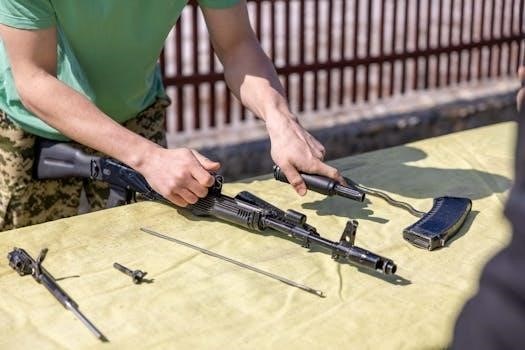10×30 party tent assembly instructions
10×30 Party Tent Assembly⁚ A Step-by-Step Guide
This guide details assembling a 10×30 party tent․ Lay out the canopy‚ assemble the frame within‚ then secure it using stakes and ropes; Consult manufacturer instructions for specifics․
Laying Out the Frame
Before you begin assembling your 10×30 party tent‚ carefully lay out all frame components on a flat‚ level surface․ Ensure ample space surrounds the area․ Arrange the poles according to the manufacturer’s diagram‚ typically found in the included instructions․ This pre-assembly organization prevents confusion and ensures proper alignment during construction․ Double-check that all parts are present and accounted for before proceeding to the next step․ Accurate placement of the frame components on the ground is crucial for a stable and correctly assembled tent․
Connecting the Frame Components
With the frame components laid out‚ begin connecting them․ Follow the manufacturer’s instructions precisely‚ as connection methods vary․ Generally‚ this involves using pins‚ clips‚ or other fasteners to join the poles at designated points․ Work methodically‚ ensuring each connection is secure and aligned correctly․ If using pins‚ make sure they are fully inserted to prevent accidental dislodging․ Take your time; rushing this step can lead to instability and potential structural problems․ Refer to diagrams if provided for visual guidance on pole and fitting alignment․ A well-connected frame is the foundation of a sturdy tent․
Raising the Tent Structure
Once the frame is fully assembled‚ carefully begin raising the tent structure․ This often involves lifting sections of the frame simultaneously‚ ensuring even distribution of weight․ Have assistants help to prevent accidental damage or injury․ Slowly raise the frame into its upright position‚ checking for any misalignments or obstructions․ Secure the top portion of the frame according to the manufacturer’s instructions․ This might involve locking mechanisms or pinning techniques․ Ensure all components are stable before proceeding․ If you encounter difficulty‚ review the assembly instructions and diagrams․ A gradual and controlled lift is crucial for a successful setup․
Securing the Tent with Stakes and Ropes
After raising the 10×30 party tent’s frame‚ secure it using the provided stakes and ropes․ Begin by positioning stakes at each corner of the tent’s base‚ ensuring they are firmly embedded in the ground․ Attach ropes to designated points on the frame‚ then to the stakes‚ creating taut lines․ Adjust rope tension to provide stability․ Additional stakes and ropes may be needed for enhanced stability‚ especially in windy conditions․ Refer to your tent’s instructions for specific placement guidelines; Proper anchoring is vital to prevent the tent from collapsing or shifting․ Regularly check the stakes and ropes during use to ensure they remain secure․ This process is critical for a safe and enjoyable event․
Essential Tools and Materials
Assembly typically requires stakes‚ ropes‚ and possibly a wrench or other tools depending on the specific tent model․ Always check the manufacturer’s instructions for a complete list․
Required Hardware
The necessary hardware for a 10×30 party tent setup varies depending on the brand and model․ Generally‚ you’ll need the frame components themselves⁚ poles‚ connectors‚ and possibly pre-attached parts․ Essential hardware also includes sturdy stakes for anchoring the tent to the ground and ropes for added stability and wind resistance․ These ropes are usually attached to designated points on the frame‚ and securing them to the stakes helps create a secure and stable structure․ Some tents might also include additional hardware like clips or fasteners for attaching sidewalls or other accessories․ Always refer to the manufacturer’s provided parts list and instructions for the specific components included with your particular tent model‚ as the exact hardware requirements can differ․ Ensure you have all the necessary items before beginning the assembly process to avoid delays or complications․
Recommended Additional Items
While not always essential‚ several additional items can significantly improve your 10×30 party tent setup experience and overall tent stability․ A rubber mallet can help gently tap frame components into place without damaging them․ Work gloves offer hand protection during assembly․ A level ensures your tent is properly aligned‚ preventing unevenness and potential issues․ Having extra stakes and ropes provides redundancy in case of breakage or loss․ Consider a tarp or groundsheet to protect the tent floor from moisture and damage․ Finally‚ for windy conditions‚ sandbags or other weights can provide added stability by anchoring the tent’s corners․ These additions may not be included in the basic package but greatly aid in a smooth and secure assembly‚ optimizing your outdoor event setup․
Troubleshooting Common Assembly Issues
This section addresses common problems⁚ frame misalignment and fabric tension issues․ Consult your manufacturer’s instructions for detailed solutions․
Addressing Frame Alignment Problems
Frame misalignment during 10×30 party tent assembly is a common issue․ If you encounter this‚ carefully check each connection point‚ ensuring all poles and joints are properly secured and aligned according to the manufacturer’s diagram․ Loose or incorrectly fitted components can cause significant alignment problems․ Double-check the placement of all connecting pieces – this often helps solve the majority of alignment problems․ If the frame is significantly misaligned‚ it may be necessary to disassemble the affected section and re-assemble it‚ paying close attention to the alignment of each component․ Take your time and carefully follow the instructions provided in your tent’s assembly guide; rushing the process often leads to errors․ If the problem persists after these steps‚ contact the manufacturer for assistance or consult online videos demonstrating proper assembly techniques; Remember‚ a properly aligned frame is crucial for overall tent stability and safety․
Fixing Fabric Tension Issues
Uneven fabric tension in your 10×30 party tent can lead to sagging and potential damage․ To address this‚ ensure all tie-down points are properly secured and evenly tensioned․ Start by checking the ropes and stakes; loose connections can cause uneven tension․ If some areas appear looser than others‚ readjust the ropes to distribute tension equally across the entire canopy․ Ensure the fabric is correctly attached to the frame at all attachment points; loose connections can also cause sagging․ If the issue persists after these adjustments‚ you might need to use additional stakes or weights to provide extra support in the sagging areas․ Refer to your tent’s instruction manual for specific guidance on tensioning the fabric․ Proper tensioning protects your investment and ensures the tent remains stable and weather-resistant․
Tips for Optimal Tent Setup
Choose a level location‚ prepare the ground by clearing debris‚ and ensure adequate space for setup and guest movement․ Consider wind direction and potential obstacles․
Choosing the Right Location
Selecting the perfect spot for your 10×30 party tent is crucial for a successful event․ Prioritize a level surface to ensure stability and prevent the tent from tilting or collapsing․ Clear away any debris‚ rocks‚ or uneven patches that could compromise the tent’s foundation․ Consider the surrounding area; ample space is needed for setup‚ guest movement‚ and potential additional structures․ Avoid areas prone to flooding or excessive shade‚ as this could impact guest comfort․ For optimal sunlight and views‚ choose a location that takes advantage of natural light and scenery‚ while also considering the positioning of the sun throughout the day․ A location that minimizes wind exposure is essential to prevent the tent from being blown around․ Finally‚ ensure easy access for setup and takedown‚ as well as convenient access for your guests․ Careful consideration of these factors will lead to a more enjoyable and successful event․
Preparing the Ground Surface
Before erecting your 10×30 party tent‚ meticulously prepare the ground․ A level surface is paramount for stability; use a rake to smooth out any bumps or dips․ For softer ground‚ consider using groundsheets or plywood to create a stable base․ Remove any sharp objects like rocks or sticks that could puncture the tent floor or cause damage to the frame․ If the ground is uneven‚ consider leveling it with topsoil or sand‚ ensuring a consistent‚ flat base for the tent’s frame and floor․ This prevents the tent from leaning or becoming unstable‚ potentially causing damage or injury․ For particularly soft ground‚ temporary paving slabs can provide excellent support‚ and prevent sinking․ Remember‚ a well-prepared surface will significantly enhance the tent’s stability and longevity․
Securing Your Tent in Windy Conditions
Strong winds pose a risk; use guy lines for added support‚ anchoring them securely to the ground․ Consider adding weights like sandbags for extra stability․
Utilizing Guy Lines Effectively
Guy lines are crucial for securing your 10×30 party tent against strong winds․ Attach them to designated points on the tent frame‚ ensuring even distribution of tension․ Stake them firmly into the ground‚ away from the tent’s base‚ using sturdy stakes driven deep enough to resist pull․ Avoid stretching the lines excessively; maintain some slack to allow for movement without snapping․ Consider using reflective material on the guy lines for enhanced visibility‚ especially at night․ Regularly check the tension of the guy lines‚ especially during periods of high winds‚ and readjust as needed to maintain optimal stability․ Proper use of guy lines significantly enhances the tent’s resistance to wind damage․
Employing Additional Weight
In addition to guy lines‚ consider employing supplemental weight to further stabilize your 10×30 party tent‚ especially in windy conditions․ Heavy-duty sandbags placed along the tent’s perimeter provide significant ground anchoring․ Alternatively‚ filled water barrels or containers offer a readily available and effective weighting solution․ Strategically position these weights at the tent’s corners and along the sides for optimal balance․ Ensure that containers are securely sealed to prevent leaks․ The added weight counteracts the force of the wind‚ preventing the tent from lifting or shifting․ Remember to choose weights appropriate for the wind conditions; heavier weights are necessary in strong winds for reliable stability․
Connecting Multiple Tents
Expand your party space by connecting multiple tents․ Use specialized tent connectors or overlapping tarps/awnings to create a seamless‚ larger covered area․
Using Tent Connectors
Many manufacturers offer specialized connectors designed to seamlessly join two or more party tents․ These connectors typically utilize zippers or strong clips that attach securely to the tent doors․ This creates a safe and convenient passageway between the connected tents‚ expanding your event space without compromising structural integrity․ Before purchasing connectors‚ ensure compatibility with your specific tent model․ Carefully follow the manufacturer’s instructions for proper attachment to avoid damage or accidental detachment during use․ Properly connected tents offer a more unified and spacious event area‚ ideal for larger gatherings or events requiring expansive covered space․ Remember to check the weather forecast and adjust your setup accordingly to maximize safety and enjoyment․ Always prioritize safety when connecting multiple tents‚ and ensure the connection points remain secure throughout the event․
Utilizing Tarps or Awnings
An alternative method for connecting multiple 10×30 party tents involves using heavy-duty tarps or awnings․ These provide a flexible and often cost-effective solution․ Carefully measure the gap between the tents to determine the necessary tarp size․ Secure the tarp or awning to each tent using ropes‚ bungee cords‚ or clamps‚ ensuring a taut and weather-resistant connection․ Consider using weighted edges or stakes to secure the tarp to the ground‚ preventing wind lift․ Choose a water-resistant tarp material for optimal protection from rain or unexpected showers․ This approach requires careful planning and execution to ensure a secure and aesthetically pleasing connection․ Remember to check the weather conditions before connecting the tents and adjust your setup accordingly․ This method allows for creative solutions in connecting tents of various sizes or styles․
Understanding Tent Capacity
Accurately estimating guest capacity for a 10×30 tent depends on the layout and furniture arrangement․ Consider space needed per person for comfortable seating and movement․
Estimating Guest Capacity Based on Layout
Determining the number of guests a 10×30 party tent can comfortably accommodate hinges significantly on the chosen layout․ A densely packed arrangement with minimal space between tables and chairs might allow for a higher guest count‚ perhaps 30-36 people if you’re placing tables and chairs close together and leaving little room for movement․ However‚ prioritizing guest comfort and ease of movement necessitates a more spacious setup․ This approach might reduce the maximum guest capacity․ Consider the size of tables and chairs; larger furniture will naturally decrease capacity․ Account for walkways and space for servers or entertainers to move around freely; A practical approach involves sketching a floor plan to visualize the arrangement and accurately estimate the number of guests the 10×30 party tent can comfortably hold‚ while still allowing for a pleasant and uncrowded experience for everyone․
Factors Affecting Maximum Capacity
Several factors beyond the tent’s dimensions influence its maximum guest capacity․ The size and style of furniture significantly impact how many people can comfortably fit․ Larger tables and chairs reduce capacity compared to smaller‚ more compact options․ The planned layout plays a crucial role; a tightly packed arrangement allows more people but sacrifices comfort and movement space․ Conversely‚ leaving ample room for walkways and traffic flow reduces overall capacity but enhances the guest experience․ Additional elements like a dance floor‚ buffet tables‚ or entertainment stage will further reduce the number of guests that can be accommodated․ Finally‚ the type of event itself affects capacity⁚ a formal seated dinner requires more space per person than a casual cocktail party․ Careful planning considering these factors is crucial for accurate capacity estimation and a successful event․



Leave a Reply
You must be logged in to post a comment.